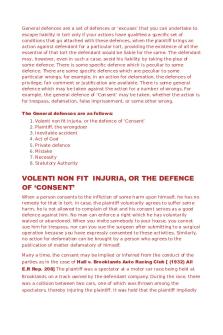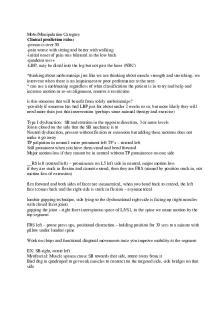Lecture notes, lecture 0-0 PDF

| Title | Lecture notes, lecture 0-0 |
|---|---|
| Course | Electromagnetism & Optics |
| Institution | University of Kent |
| Pages | 6 |
| File Size | 218.4 KB |
| File Type | |
| Total Downloads | 68 |
| Total Views | 177 |
Summary
Download Lecture notes, lecture 0-0 PDF
Description
PH504: Introduction 1. Preparation The entire course is delivered in 3 chunks with 3 class tests. There will be plenty of assignments with answers provided. Electrostatics Electromagnetism Optics Prof Michael Smith will deliver the first 10 lectures and a class test. Lecture notes for electrostatics will be posted on: http://astro.kent.ac.uk/mds/Modules/modules.htm Previous years’ notes and other details are also available. Experiments on electrostatics will not be undertaken. Therefore, you might wish to watch Walter Lewin’s lectures on video (not a requirement). You can download and save from: http://ocw.mit.edu/courses/physics/8-02-electricity-and-magnetism-spring2002/video-lectures/ http://ocw.mit.edu/ans7870/8/8.02/videolectures/wl-802-lec1-220k.rm Also online on youtube, and at http://ocw.mit.edu/OcwWeb/Physics/8-02Electricity-andMagnetismSpring2002/CourseHome/ MDS Topics: 1. 2. 3. 4. 5. 6. 7. 8. 9. 10.
Intro, Complex numbers, Partial differentiation Vectors Coulomb’s law, Gauss’ law Potential energy and electric potential Electric dipole Gauss law Capacitance Dielectrics; polarisation Boundary conditions for E, D
Useful webnotes: 1
http://farside.ph.utexas.edu/teaching/em/lectures/lectures.htm l http://www.david-mowbray.staff.shef.ac.uk/
Recommended Text Book Many textbooks cover the subject matter of this part of the course.
Recommended: 'Electricity and Magnetism' by W J Duffin (McGraw-Hill), currently in its fourth edition. This provides a good, clear description of the physics with a comprehensive discussion of the underlying mathematics.
An alternative book is 'Electromagnetism' by I S Grant and W R Phillips (Wiley) 1990, part of the Manchester physics series. This is of a similar level to Duffin although the general layout, diagrams etc are less clear in places. A more recent book is ‘Classical Electromagnetism’ by R H Good. The mathematics level of this book is quite high and subjects are covered in a very different order to most other books. However it does contain many worked problems and more detailed discussions of some of the conceptual points and assumptions.
2. Why Bother with electrostatics? 1. Strength: Even though electrostatically induced forces seem to be rather weak, the electrostatic force between e.g. an electron and a proton, that together make up a hydrogen atom, is about 40 orders of magnitude stronger than the gravitational force acting between them. For most objects, the number of negative charges equals the number of positive charges, giving a net charge of zero. 2
2. Annoyance. Static charge, bad hair days, wrinkled clothes, dog hair that I can’t get off of my pants. 3. Application Ink Jet Printer – words written by deflection of ink droplets in electrostatic fields
Ion Mass Spectrometers. Why do they swab your bags at the airport? The compounds acquired are desorbed and ionized. The ions are accelerated toward the detector by a constant electric field gradient in the drift region. Since the ‘flight’ depends on ion mass and charge, explosives can be detected.
3
3. In a Nutshell There are two types of charges: positive and negative. Like charges repel and opposite charges attract. Coulomb’s law: F = Q1Q2/(40r2) where 0 is the permittivity of free space. A conductor allows electric charge to travel through it with ease. Charges can flow through a metal with very little resistance. An insulator does not, it blocks it. Rubber, for instance, has its atoms arranged such that it is very difficult for electric charge to flow through it. Rubber is considered to be an insulator. All materials have a certain specific conductivity (Siemens/m). The conductivity of a material depends on the material’s arrangement of free electrons. Below is a chart of some common materials and their conductivities. Electrical Conductivity Material (1/(ohm*m)) 60 x 106 60 x 106 5 x 106 10-8 - 10-14 10-10 - 10-14 10-13 - 10-16
Silver Copper Lead Wood Glass Hard Rubber
Values taken from Tipler, Paul A. Physics, Third Edition. 1991.
A person's body acts as a conductor. The skin has a very large resistance (on the order of MegaOhms). 4
The salt water (electrolyte) solution that is in your body is designed specifically to conduct electricity, so that your nerve impulses can reach the muscles. Water with absolutely no impurities conducts electricity very poorly. Triboelectric Series. When certain types of materials are rubbed against other certain types, charge may be transferred from one to the other. The amount and type of charge is determined by the Triboelectric Series. The Triboelectric Series is a list of materials which determines which materials will become positively charged and which will become negatively charged when rubbed together. A sample portion of the Series is shown below. To read the chart, those materials nearer the top will become positively charged and those nearer the bottom will become negatively charged. For instance, when Teflon is rubbed against silk, the Teflon becomes negatively charged and the silk becomes positively charged.
Positive Charge Human hair Nylon Wool Silk Paper Cotton Wood Hard rubber Teflon Negative Charge Aircraft & Space launch Vehicles can become charged.
Polarisation. When an uncharged object is placed near a charged object its charges rearrange themselves. Those charges attracted 5
to the charged object move towards the charged object and those charges repelled move away. This effect is known as polarization. Charges on a conductor tend to gather at sharp points. A metal cone, for instance, which has been charged will have a lot of charge at the point, and much less charge elsewhere. WHY ??
6...
Similar Free PDFs

00-intro - Lecture notes 1
- 20 Pages

00-COKE-01 - Lecture notes 1-7
- 25 Pages

Lecture notes, lecture 3
- 5 Pages

Lecture notes, lecture Subspaces
- 21 Pages

Lecture notes, lecture 14
- 3 Pages

Lecture notes, lecture 6
- 3 Pages

Lecture notes, lecture 7b
- 4 Pages

Lecture notes, lecture 13
- 12 Pages

Lecture notes, lecture 12
- 9 Pages
Popular Institutions
- Tinajero National High School - Annex
- Politeknik Caltex Riau
- Yokohama City University
- SGT University
- University of Al-Qadisiyah
- Divine Word College of Vigan
- Techniek College Rotterdam
- Universidade de Santiago
- Universiti Teknologi MARA Cawangan Johor Kampus Pasir Gudang
- Poltekkes Kemenkes Yogyakarta
- Baguio City National High School
- Colegio san marcos
- preparatoria uno
- Centro de Bachillerato Tecnológico Industrial y de Servicios No. 107
- Dalian Maritime University
- Quang Trung Secondary School
- Colegio Tecnológico en Informática
- Corporación Regional de Educación Superior
- Grupo CEDVA
- Dar Al Uloom University
- Centro de Estudios Preuniversitarios de la Universidad Nacional de Ingeniería
- 上智大学
- Aakash International School, Nuna Majara
- San Felipe Neri Catholic School
- Kang Chiao International School - New Taipei City
- Misamis Occidental National High School
- Institución Educativa Escuela Normal Juan Ladrilleros
- Kolehiyo ng Pantukan
- Batanes State College
- Instituto Continental
- Sekolah Menengah Kejuruan Kesehatan Kaltara (Tarakan)
- Colegio de La Inmaculada Concepcion - Cebu






